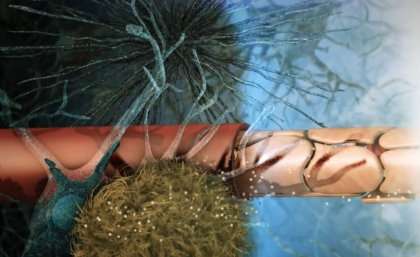Ultrasound and drug research holds promise for Alzheimer's disease

Non-invasive ultrasound improves the delivery to the brain of a therapeutic antibody targeting Alzheimer's disease, University of Queensland researchers have found.
Scientists from UQ's Queensland Brain Institute (QBI), previously showed non-pharmacological scanning ultrasound reversed Alzheimer's symptoms and restored memory in mice.
The new research found that ultrasound alone cleared toxic tau protein clumps, but combining ultrasound with an antibody treatment was more effective than either treatment alone in removing protein clumps and reducing Alzheimer's symptoms in mice.
QBI director Professor Pankaj Sah said the research was made possible through the support of the State and Federal Governments, and philanthropic support led by the Clem Jones Foundation.
"The discovery is another promising step made by QBI researchers towards future therapeutic treatments for dementia," Professor Sah said.
"Excitingly, the research shows that ultrasound may also be a viable treatment for other disorders in which proteins aggregate in the brain – including Parkinson's and motor neuron disease."
Professor Jürgen Götz, the study's leader and Director of QBI's Clem Jones Centre for Ageing Dementia Research (CJCADR), said the combination treatment increased uptake of the therapeutic antibody into the brain and its individual neurons, and could be used to make treatments for brain diseases more cost-effective.
"With vaccination trials in dementia currently ongoing elsewhere, the problem is that only 0.1% of the therapeutic antibodies enter the brain, which would make a potential treatment for Alzheimer's very costly," said Professor Götz.
The paper's lead author, Dr Rebecca Nisbet, said antibody therapies could cost an estimated $25,000 to $100,000 per patient per year, and their research could drastically reduce the cost of these treatments.
Delivering drugs to the brain is difficult because of the blood–brain barrier, which protects from toxins in the bloodstream; however, the ultrasound approach temporarily opens the barrier, increasing the uptake of drug treatments and restoring memory functions.
The UQ researchers are conducting ongoing work to translate the research into a therapy for patients in coming years, and in the meantime, patients are being advised to contact their doctors.
Alzheimer's disease is the most common form of dementia, and the number of dementia cases in Australia is expected to rise to 900,000 by 2050.
More information: Combined effects of scanning ultrasound and a tau-specific single chain antibody in a tau transgenic mouse model, Brain (2017). DOI: 10.1093/brain/awx052



















